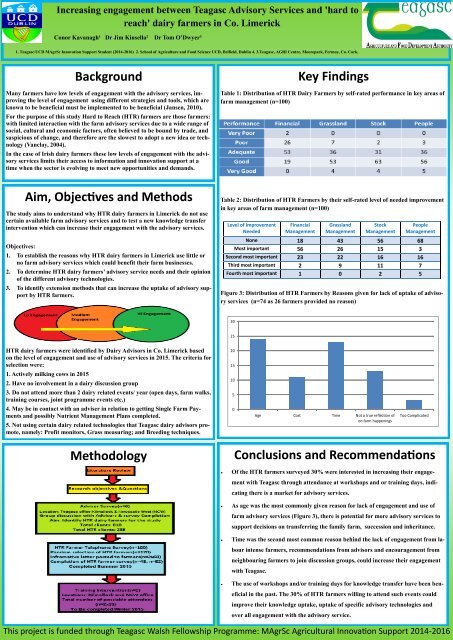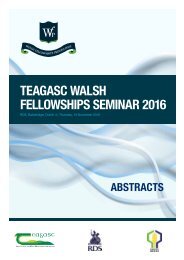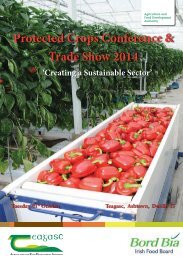Driving Farm Innovation through Knowledge Transfer
1S93ppX
1S93ppX
You also want an ePaper? Increase the reach of your titles
YUMPU automatically turns print PDFs into web optimized ePapers that Google loves.
Increasing engagement between Teagasc Advisory Services and 'hard to<br />
reach' dairy farmers in Co. Limerick<br />
Conor Kavanagh¹ Dr Jim Kinsella²<br />
Dr Tom O’Dwyer³<br />
1. Teagasc/UCD MAgrSc <strong>Innovation</strong> Support Student (2014-2016) 2. School of Agriculture and Food Science UCD, Belfield, Dublin 4. 3.Teagasc, AGRI Centre, Moorepark, Fermoy, Co. Cork.<br />
Background<br />
Many farmers have low levels of engagement with the advisory services, improving<br />
the level of engagement using different strategies and tools, which are<br />
known to be beneficial must be implemented to be beneficial (Jansen, 2010).<br />
For the purpose of this study Hard to Reach (HTR) farmers are those farmers:<br />
with limited interaction with the farm advisory services due to a wide range of<br />
social, cultural and economic factors, often believed to be bound by trade, and<br />
suspicious of change, and therefore are the slowest to adopt a new idea or technology<br />
(Vanclay, 2004).<br />
In the case of Irish dairy farmers these low levels of engagement with the advisory<br />
services limits their access to information and innovation support at a<br />
time when the sector is evolving to meet new opportunities and demands.<br />
Key Findings<br />
Table 1: Distribution of HTR Dairy <strong>Farm</strong>ers by self-rated performance in key areas of<br />
farm management (n=100)<br />
Aim, Objectives and Methods<br />
The study aims to understand why HTR dairy farmers in Limerick do not use<br />
certain available farm advisory services and to test a new knowledge transfer<br />
intervention which can increase their engagement with the advisory services.<br />
Objectives:<br />
1. To establish the reasons why HTR dairy farmers in Limerick use little or<br />
no farm advisory services which could benefit their farm businesses.<br />
2. To determine HTR dairy farmers’ advisory service needs and their opinion<br />
of the different advisory technologies.<br />
3. To identify extension methods that can increase the uptake of advisory support<br />
by HTR farmers.<br />
Table 2: Distribution of HTR <strong>Farm</strong>ers by their self-rated level of needed improvement<br />
in key areas of farm management (n=100)<br />
Level of Improvement<br />
Needed<br />
Financial<br />
Management<br />
Grassland<br />
Management<br />
Stock<br />
Management<br />
People<br />
Management<br />
None 18 43 56 68<br />
Most important 56 26 15 3<br />
Second most important 23 22 16 16<br />
Third most important 2 9 11 7<br />
Fourth most important 1 0 2 5<br />
Figure 3: Distribution of HTR <strong>Farm</strong>ers by Reasons given for lack of uptake of advisory<br />
services (n=74 as 26 farmers provided no reason)<br />
30<br />
25<br />
HTR dairy farmers were identified by Dairy Advisors in Co. Limerick based<br />
on the level of engagement and use of advisory services in 2015. The criteria for<br />
selection were:<br />
20<br />
15<br />
1. Actively milking cows in 2015<br />
2. Have no involvement in a dairy discussion group<br />
10<br />
3. Do not attend more than 2 dairy related events/ year (open days, farm walks,<br />
training courses, joint programme events etc.)<br />
5<br />
4. May be in contact with an adviser in relation to getting Single <strong>Farm</strong> Payments<br />
and possibly Nutrient Management Plans completed.<br />
5. Not using certain dairy related technologies that Teagasc dairy advisors promote,<br />
namely: Profit monitors, Grass measuring; and Breeding techniques.<br />
0<br />
Age Cost Time Not a true reflection of<br />
on farm happenings<br />
Too Complicated<br />
Methodology<br />
Conclusions and Recommendations<br />
<br />
Of the HTR farmers surveyed 30% were interested in increasing their engagement<br />
with Teagasc <strong>through</strong> attendance at workshops and or training days, indicating<br />
there is a market for advisory services.<br />
<br />
As age was the most commonly given reason for lack of engagement and use of<br />
farm advisory services (Figure 3), there is potential for more advisory services to<br />
support decisions on transferring the family farm, succession and inheritance.<br />
<br />
Time was the second most common reason behind the lack of engagement from labour<br />
intense farmers, recommendations from advisors and encouragement from<br />
neighbouring farmers to join discussion groups, could increase their engagement<br />
with Teagasc.<br />
<br />
The use of workshops and/or training days for knowledge transfer have been beneficial<br />
in the past. The 30% of HTR farmers willing to attend such events could<br />
improve their knowledge uptake, uptake of specific advisory technologies and<br />
over all engagement with the advisory service.<br />
This project is funded <strong>through</strong> Teagasc Walsh Fellowship Programme: MAgrSc Agricultural <strong>Innovation</strong> Support 2014-2016




